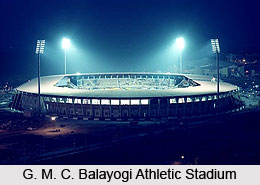 G. M. C. Balayogi Athletic Stadium is a well known athletic stadium in Hyderabad. This stadium is named after G. M. C. Balayogi, who was an Indian lawyer and politician. He served as the speaker of Lok Sabha. On March 3, 2002, G. M. C. Balayogi died in crash of a Bell 206 helicopter in Krishna District of Andhra Pradesh. This stadium is located at a latitudinal and longitudinal extent of 17 degree 26 minutes and 46 seconds north to 78 degree 20 minutes and 39 second east.
G. M. C. Balayogi Athletic Stadium is a well known athletic stadium in Hyderabad. This stadium is named after G. M. C. Balayogi, who was an Indian lawyer and politician. He served as the speaker of Lok Sabha. On March 3, 2002, G. M. C. Balayogi died in crash of a Bell 206 helicopter in Krishna District of Andhra Pradesh. This stadium is located at a latitudinal and longitudinal extent of 17 degree 26 minutes and 46 seconds north to 78 degree 20 minutes and 39 second east.
G. M. C. Balayogi Athletic Stadium, which was renamed as Bhagya Reddy Varma Stadium was constructed in the year 2002. This stadium has a covered seating capacity of 30,000.
G. M. C. Balayogi Athletic Stadium is a magnificent stadium, built-up area of 14850.33 square meters, which is 3.67 acres, with 400 meters, eight lane synthetic athletic track, with provision for a Football field. There is a 4-lane synthetic surface and 4-lane grass surface track for warm-up and training adjacent to the main stadium. The stadium can stage day and night events with obstruction free viewing for all spectators. The stadium has two VIP lounges. The football field covers the 105meter x 68metre at the centre of the stadium. There are four lanes of Grass Track for one lap length.
G. M. C. Balayogi Athletic Stadium is an ultra modern stadium with eight line competition synthetic athletic track and four-lane synthetic practice track.
It uses the latest high-mast lighting for day-night events. It provides the obstruction-free viewing for all spectators.
G. M. C. Balayogi Athletic Stadium is a very charming stadium amidst breath-taking landscape. The 2003 Afro-Asian Games were also held in G. M. C. Balayogi Athletic Stadium. In G. M. C. Balayogi Athletic Stadium, more than 30,000 people came to watch the amazing opening ceremony. The opening ceremony was about two hours and forty minutes with an amazing laser show.
During the civil agitations in Telangana in 2009, this stadium has been renamed to Bhagya Reddy Varma Stadium. Bhagya Reddy Varma or Madari Bagaiah was an Indian leader of the Adi Hindu Movement. He was known as the "Father of Dalit Movement in Andhra Pradesh".



















